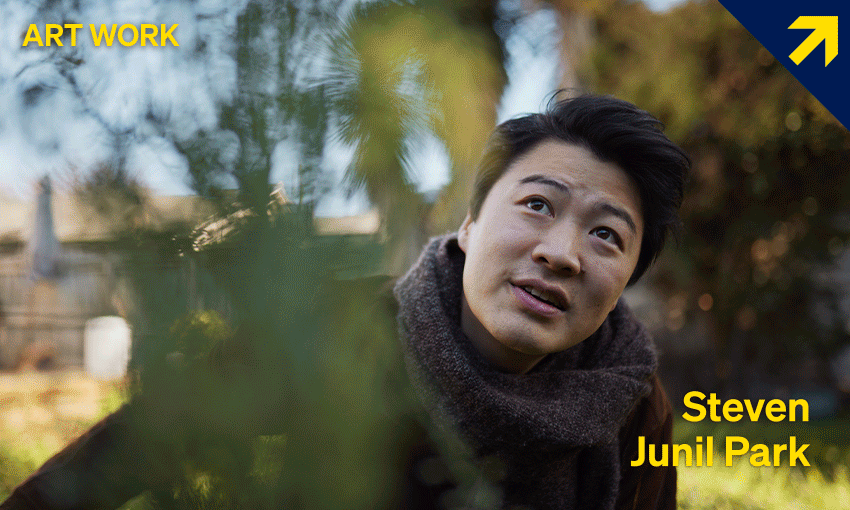Steven Junil Park is a multidisciplinary artist living and working in Ōtautahi. Under the moniker 6×4, he has produced functional objects with a focus on clothing and textiles for over a decade. He has had work presented at Objectspace, featured in music videos by Aldous Harding and Tiny Ruins, and onstage in Scenes from a Yellow Peril.
How he describes his arts practice
My background was in fine arts and I studied at Elam School of Fine Arts in Tāmaki Makaurau but during that time I grew quite disillusioned with the way that art making was expected to be done by us students and how we were supposed to engage with artmaking.
I was always interested in making clothing from a young age. It was a really great way to deal with ideas of identity and selfhood; all of these things I found hard to understand and unravel from my own experience being queer and a Korean person growing up in Ōtautahi. I think my experience of growing up was that the things around me didn’t have any space for me and my experience.
I started making clothing when I was at Elam and stopped making traditional art in the fine arts sense – I only focussed on making functional objects. Since then I haven’t really stopped. My main practice people would know about is 6×4. I just kept doing it, kept making clothes, partly out of practicality because it was the only thing that I could make when I didn’t have access to the workshops and the facilities there. I could just have a sewing machine in the house and make at home.
My interest in craft and functional objects has never gone away. It’s always been there, through the past ten years of me making clothing for different stockists and also from the broad range of technical things that I’ve picked up at art school from varying highly skilled technicians. I was able to learn jewellery, joinery, woodwork, welding – any kind of practical thing to do with making was something I learned while I was at Elam.
What an average work day looks like
My average day is always very different. When I’m really busy, it’s waking up and going into the studio and working the whole day, then going to sleep. My partner and I live together and when we are really really busy, sometimes we would just eat this powdered food because we’re so busy we don’t even have time to cook.
But that’s not sustainable. We’ve done that for periods, but what I would like it to be is that I would wake up, go for a swim, do some yoga, do some writing, do some reading, something for me where I can feel like a person. Then I’d do some work pretty solidly, then have dinner in the evening and relax. It’s very rare that I can do that.
I work from home, so the whole energy of the house is centered on making. It’s quite rare that I am at home without a backlog of things I need to achieve.
The physical toll it takes
It’s only in the past three years I’ve tried to have a balance where I engage with activities like yoga, swimming, running, something like that. I’m not that good at it because I haven’t had a practice of it. I’ve spent my whole adult life making stuff, and it’s only as I’ve become older that I’ve realised that isn’t sustainable.
We all know that physical health and mental health are all interconnected. Having a better relationship to those things is good for me and my practice, but it’s hard because I’m in a context where I’m having to commodify my work.
The thing I do is a very human practice. We all have a human birthright to have an interest, a joy, a love in our clothing. It’s a fabrication of the industry to think that it’s vain, vapid or superficial to talk about clothing in a really loving and soulful way. I think that’s a really mean and cruel way that the industry has made us feel about ourselves and the things that we wear.
I want to think about and frame clothing in that [human] way, but I’m having to commodify the things that I’m making in order to make a living. Which everyone is! But it means that I’m having to push myself to make enough to get by.
His – and our – relationship to clothing
Our relationship to clothing is in a really bad place in so many different ways. The Industrial Revolution was kicked off through textiles, but the reality of what textiles have been for us historically is something that is about ancestry, meaning and who we are, where we come from and the very deeply localised things that talk about who we are, how we relate to each other. Clothing was very, very meaningful.
But my experience of clothing through fast fashion in the 90s is that there’s one of a million, and you just buy it. It’s really cheap. You don’t really know who made it or where it comes from. After you’re done with it, it just goes into the bin. It’s a massive disconnect.
Historically, clothing wasn’t done like that. I’m trying to make things that have that meaning and story in it. I’m still making in that way, I’m a solo studio maker, I make stuff alone, and I spend a lot of time alone.
The support that has made his arts practice sustainable
The biggest thing, overall, is that I had a pretty middle-class upbringing. We immigrated to the country when I was six years old from Korea, but my parents were pretty middle class and more than that they were really, really loving and supportive. Anything I wanted to do, they were like, “Just try hard. If it doesn’t work out for you, you can give up. But before you give up, try really, really hard.”
That’s a massive thing that I want to acknowledge. I can’t imagine what it would have been like if I hadn’t had that. That’s been a really big thing for me, because that’s allowed me to go down a pretty unstable path that is quite self-indulgent. Like, “I want to think about who I am for my living!” Not everybody gets the chance to do that, so I take it quite seriously that I have had that opportunity. I take it seriously that I have been given this chance and I want to do it to the best of my ability.
The other thing that allowed me to do what I do is the support of Sharon Ng (NG Boutique), who is one of the cornerstones of New Zealand fashion. Without that support, pretty unconditionally, of her to take my stuff and put it in the shop and in front of an audience that is already established. If you don’t have something like that, it’s really, really hard. Even if you’re making interesting work, if you can’t access people who can afford it, realistically, it’s hard to continue doing it. I was working there, which let me interact with people and talk about what I was making, and be in proximity to work that pushed me to be better at making. I don’t think I would’ve been able to do what I’m doing without having those experiences.
The contexts in which we show, and get work across to the public, are quite conditional. I suppose they have to be, but with something as personal as what I do, it’s quite important to have that unconditional environment in which to show my work.
Structural changes that would make his practice easier going ahead
We are seeing funding bodies and creative spaces having to work really hard to stay afloat and this is burning people out. They stay afloat at the expense of people who believe in it and keep these things alive. I think the thing that I really believe in is that arts is something that is not auxiliary to our lives.
Art and particularly craft for me is something that allows us to connect with each other, but connect to parts of humanity. They’re very human things to do – singing, dancing, making clothes – all these things are packaged as arts but they’re these elements of what it means to be a person. They’re things that bring us together, they intermingle us to have stronger bonds, stronger communities.
People often go, “I can’t sew. I can’t sing. I can’t dance.” Those things are inherently human activities. They belong to us. But because they’ve been commodified and sold back to us, it makes people feel disconnected from those things.
I would like to see those things be naturally integrated into the way that we interact with each other, rather than having to pay for classes to do this and this and this. You can get together with friends and just mend stuff!
The continued appeal of his career
The appeal of clothing, and functional objects, is they are quite deeply connected to cultural traditions and social traditions. For me, who felt weirdly disconnected from my cultural heritage as well, it felt like an “in” for me. Doing that for a really long time, I’ve started to recognise that what I’m interested in now more than ever, is trying to create that kind of community.
I feel very lucky and very privileged that I can have a career in the arts. So many people can’t. I feel weird about having a career in the arts when a lot of people don’t have time to learn how to sew on a button. That’s not fair. That’s not cool. I think everyone should have some sort of way to tell their stories and connect to each other through those things. It’s not structural support for me necessarily, it’s structural – and cultural – support for everyone to not feel so lonely all the time.

